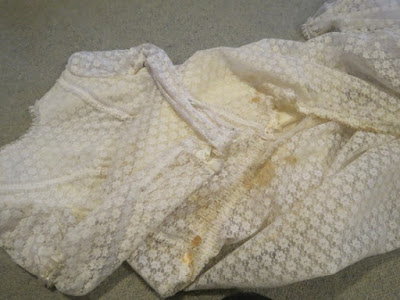I turned up to the address I was given which turned out to be an old block of units in inner Melbourne. The outside was not at all interesting.
Inside, I eventually worked out, was the unit belonging to the lady's mother, who had died a couple of months previous to this. The nightgowns as well as gloves, handbags, handkerchiefs and some shoes were laid out on the couch for me to look at, and they were lovely.
 |
| Pink nightgown with lace and applique |
 |
| Ivory nightgown with lace inserts |
 |
| Peach nightgown with lace inserts |
 |
| Ivory nightgown with applique and embroidery |
The clothing had all belonged to the lady's mother, who had travelled from New York to be married in Melbourne in 1952. There were six of these gorgeous rayon nightgowns, all different colours and with different sleeves and trims, but all bias cut with the same basic style of bodice. These had been custom made for the trousseau in New York and for whatever reason the lady had never worn any of them. (Maybe she didn't like ironing!!).
There was also this beautiful satin bedjacket:
 |
| Pink satin bedjacket with coffee lace |
And two green glass jars stuffed full of grey seamed nylon stockings. The lady told me that for some reason, on the journey the customs men made her mother take the stockings out of the packets and throw away the boxes. I later thought this must have been because she had so many, they probably thought she was going to sell them without paying import duties or something.
The unit itself did not appear to have been changed since the newlyweds moved in, in 1952. The lounge suite was fabulous, and cobalt blue! All of the bedroom furniture was original and built in, custom made for the unit. The cupboards and wardrobes were still full and the lady was happy to show me through the contents of the wardrobes.
We found her mother's bras. This lady had all her bras custom made in Melbourne. They are made of beautiful cotton jacquard with padded silk straps. The lady told me there had also been longline bras but that she had cut them up! ):
 |
| Custom made bra |
And what a collection of fabulous handbags! These two are snakeskin:
And the little evening bag:
And gloves! The lady had a friend in the industry and must have owned at least 40 pairs.
Unfortunately, my pockets were not deep enough to take away all of the treasures, but the lady's daughter has promised to save them for me until the next time I may be passing! One day soon I will go back for the evening gowns, shoes, knitwear, 60s slips and more amazing handbags! I was thrilled that the lady's daughter shared this with me, thank you.



















































